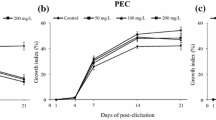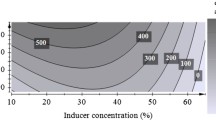Abstract
Some ammonium oxalate soluble pectic fragments prepared from cultured cell wall ofEphedra distachya elicited the accumulation ofp-coumaroylamino acids (p-CAA) inE. distachya cultures while water soluble and alkali soluble fractions had no activity. Partial purification of the pectic fragments fraction using DEAE-cellulose chromatography afforded two active fractions (PS-I and PS-II) which were composed of mainly uronic acids (98–99 w/w%). They elicited the accumulation ofp-CAA in an amount of 52–60 nmol per gram fresh weight of cultures. The acidic sugar compositions of PS-I and PS-II were found to be galacturonic acid and glucuronic acid by TLC analysis. They were supposed to act as endogenous elicitors ofp-CAA accumulation. In order to investigate the effect of ethylene onp-CAA accumulation, Ethrel, which is known as ethylene generator, and ACC (1-aminocyclopropane-1-carboxylic acid), a direct precursor of ethylene biosynthesis, were added to the culture. However, they did not affect on the accumulation ofp-CAA. AVG (aminoethoxyvinylglycine), a tentative inhibitor of ethylene biosynthesis, did not affect on the elicitor activity of yeast-derived mannan glycopeptide elicitor (Con A-II), either. Consequently, no relationships between ethylene and p-CAA accumulation were recognized. Several tentative elicitors were tested for their activity. Commercial yeast glucan, CuCl2, laminarin and laminariheptaose had slight activity whereas α-methylmannopyranoside and commercial yeast mannan had no elicitor activity. α-Methylmannopyranoside which has been known as a tentative inhibitor, of glucan elicitor inGlycine max did not affect on the elicitor activity of Con A-II.
Similar content being viewed by others
References Cited
Ayers, A. R., Ebel, J., Valent, B. and Albersheim, P., Host-pathogen interactions.Plant Physiol., 57, 760–765 (1976).
Blumenkrantz, N. and Asboe-Hansen, G., New method for quantitative determination of Uronic acid.Anal. Biochem., 54, 484–489 (1973).
Brooks, C. J. W. and Watson, D. G., Phytoalexins.Nat. Product Rep., 427–459 (1985).
Cambell, M. M. and Ellis, E. B., Fungal elicitor-mediated responses in pine cell cultures.Planta, 186, 409–417 (1992a).
Cambell, M. M. and Ellis, E. B., Cell wall-bound phenolics.Phytochemistry, 31, 737–742 (1992b).
Chalutz, E. De Vay, J. E. and Maxie, E. C., Ethylene induced isocoumarine, formation in carrot root tissue.Plant Physiol., 44, 235–241 (1969).
Dische, Z., Qualitative and quantitative colorimetric determination of heptose.J. of Biol. Chem., 204, 983–997 (1953).
Dixon, R., The phytoalexin response: elicitation, signaling and control of host gene expression.Biol. Rev., 61, 239–291 (1986).
Hahn, G. M., Darvill G. A. and Albersheim, P., Hostpathogen interactions.Plant Physiol., 68, 1161–1169 (1981).
Lieberman, M., Biosynthesis and action of ethylene.Ann. Rev. Plant Physiol., 30, 533–591 (1979).
Lowry, H. O., Rosebrough, A. Farr, L. and Randall, J. R., Protein measurement with the Folin phenol reagent.J. of Biol. Chem., 193, 265–275 (1951).
Marcan, H., Jarvis, M. C. and Friend, J., Effect of methyl glycosides and oligosaccharides on cell death browning of potato tuber discs induced by mycelial components ofPhytophthora infestans.Physiol. Plant Pathol., 14, 1–9 (1979).
Möller, K. O. and Böger, H.,Arbeiten aus der Biologischen Bundesanstalt für Land-und Forstwirtschaft (Berlin). 23, 189–231 (1940).
Nothnagel, E. A., McNeil, M., Albersheim, P. and Dell, A., Host-pathogen interactionsPlant Physiol., 71, 916–926 (1983).
Pegg, G. F., The involvement of ethylene in plant pathogenesis. In Heitefuss, R. and Williams, P. H. (Eds.),Encyclopedia of Plant Physiology, New Series, Vol. 4. Springer-Verlag, Heidelberg, 1976, pp. 582–591.
Paradies, I., Konze, J. R., Elsner, E. F. and Daxton, J., Ethylene: Indicator but not inducer of phytoalexin synthesis in soybean.Plant Physiol., 66, 1106–1109 (1980).
Sisler, E. C. and Yang, S. F., Anti-ethylene effects ofcis-2-butene and cyclic oleffins.Phytochemistry, 23, 2765–2768 (1984).
Song, K. S., Ishikawa, Y., Kobayashi, S., Sankawa, U. and Ebizuka, Y.,N-Acylamino acids fromEphedra distachya cultures.Phytochemistry 31, 823–826 (1992).
Song, K. S. Tomoda, T., Shimizu N., Sankawa, U. and Ebizuka, Y., Yeast-derived mannan glycopeptide elicits the accumulation ofp-coumaroylamino acids inEphedra distachya cultures. Submitted toPhytochemistry (1993a).
Song, K. S., Sankawa, U. and Ebizuka, Y., D-Alanine acts as an elicitor of the accumulation ofp-coumaroylamino acids inEphedra distachya cultures. Submitted toPhytochemistry (1993b).
Srisuma, N., Ruengsakulrach, S., Ueberax, A. M., Bennink, R. M. and Hammerschmidt, R., Cell wall polysaccharides of navy beans (Phaseolus vulgaris).J. of Agric. Food Chem., 39, 855–858 (1991).
West, C. A., Moesta, P., Jin, D. F., Lois, A. F. and Wickham, K. A., The role of pectic fragments of the plant cell wall in the response to biological stress., In Alan, R. (Eds.),Cellular and Molecular Biology of Plant Stress, Liss Press, New York, 1985, pp. 335–349.
Author information
Authors and Affiliations
Additional information
Dedicated to Prof. Seung-Jo Yoo to cerebrate his glorious retire.
Rights and permissions
About this article
Cite this article
Song, KS., Sankawa, U. & Ebizuka, Y. Elicitors which induce the accumulation ofp-coumaroylamino acids inEphedra distachya cultures. Arch. Pharm. Res. 17, 26–30 (1994). https://doi.org/10.1007/BF02978243
Received:
Issue Date:
DOI: https://doi.org/10.1007/BF02978243




